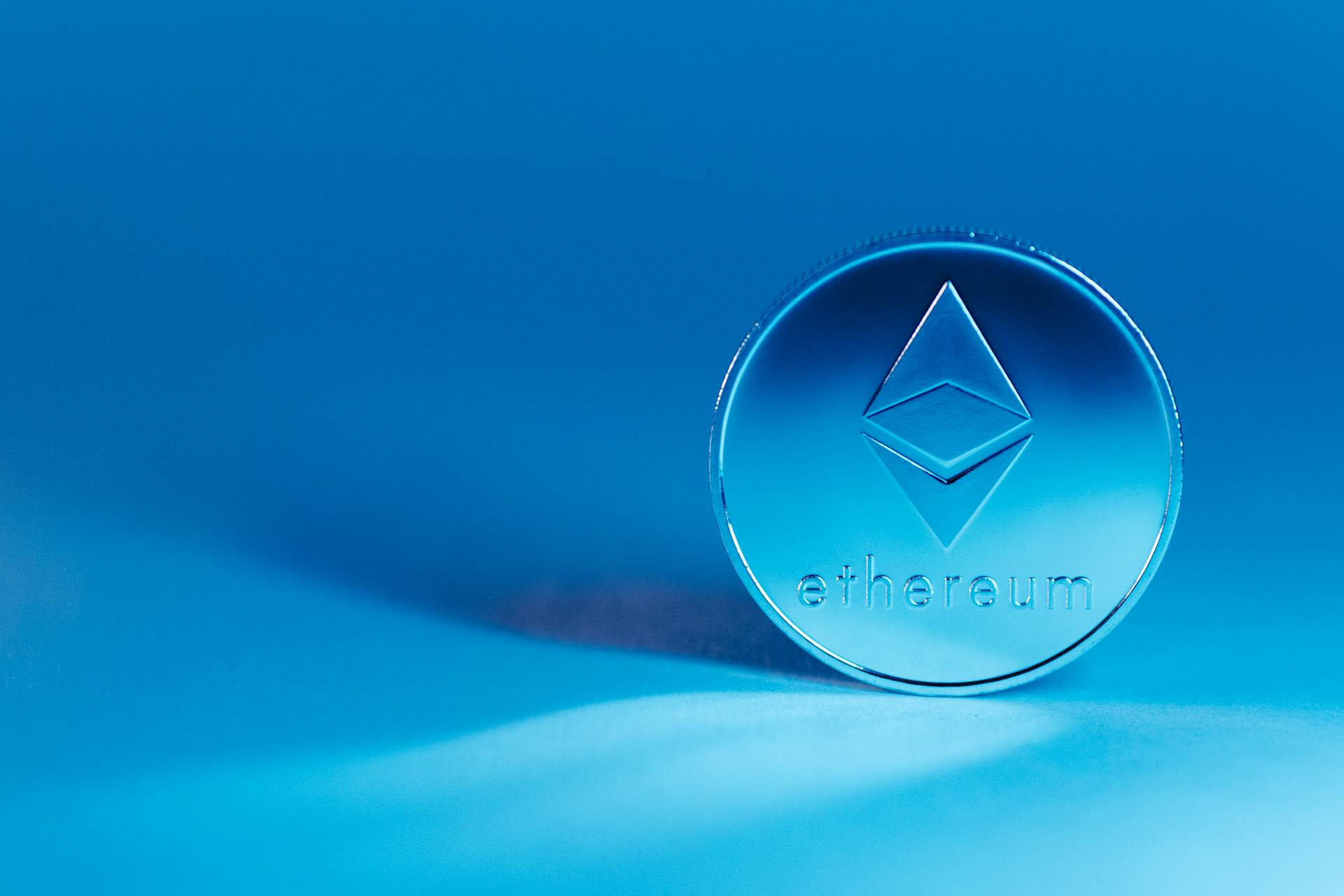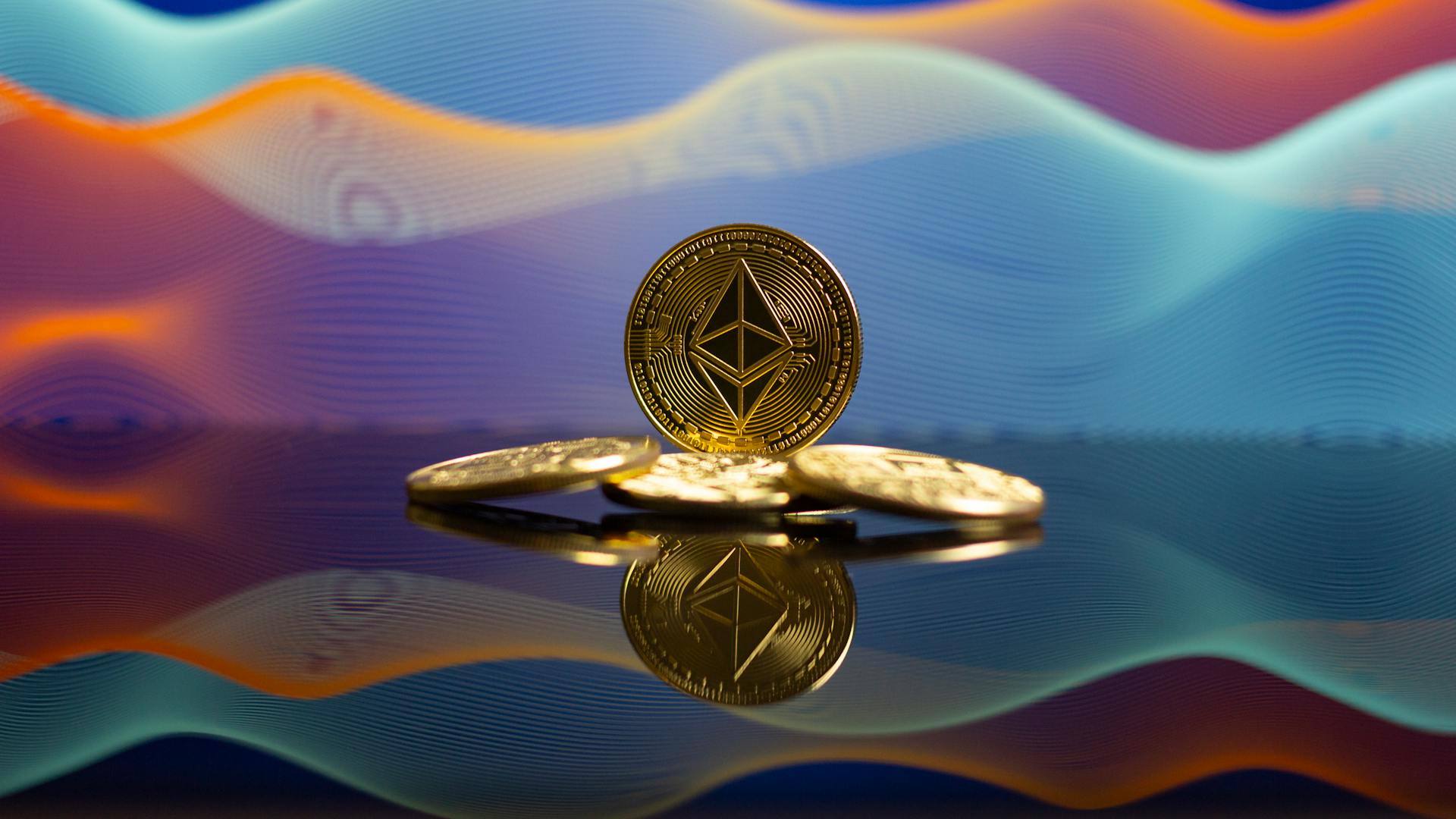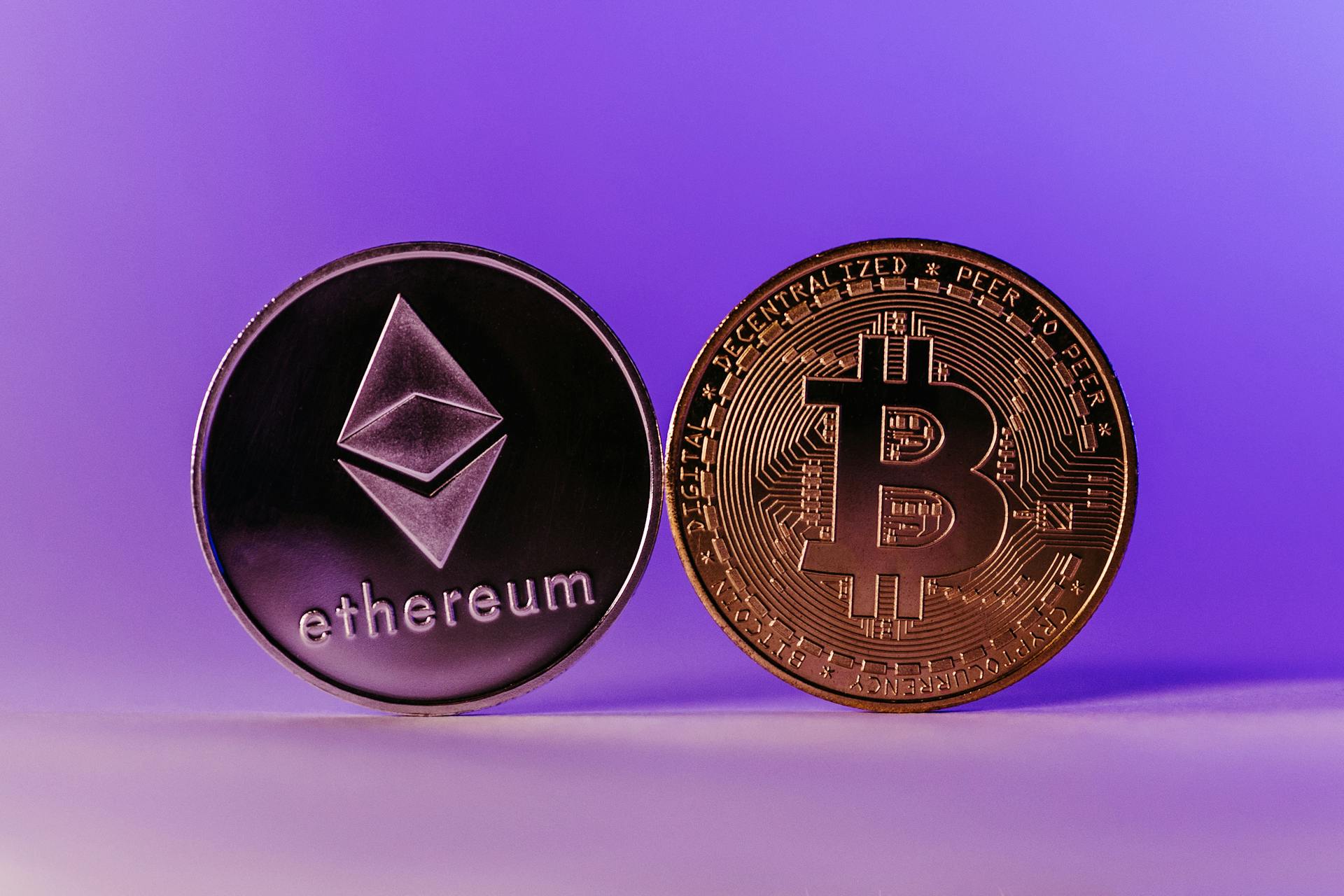
To trade Ethereum online, you'll need a reliable exchange platform. Binance and Coinbase are two popular options that support Ethereum trading.
First, create an account on your chosen exchange. You'll need to provide some basic information and verify your identity before you can start trading.
Choose a secure wallet to store your Ethereum. A hardware wallet like Ledger or Trezor is a good option, as it provides an additional layer of security.
To buy Ethereum, navigate to the exchange's trading platform and select the Ethereum pair you want to trade. For example, if you want to buy Ethereum with US dollars, you'll select the ETH/USD pair.
Once you've selected your pair, you can set a price limit and execute the trade. Be careful, as the price of Ethereum can fluctuate rapidly.
Keep in mind that trading Ethereum involves risk, and you could lose some or all of your investment. It's essential to do your research and set a budget before starting to trade.
Check this out: Is Trust Wallet Easy to Use to Send Crypto
Trading Strategies
There are several Ethereum trading strategies that you can use, each with different risk levels and suited for various market conditions and trader preferences. Day trading, swing trading, HODLing, dollar-cost averaging (DCA), and breakout trading are some of the approaches you can take.
To make informed decisions, you need to identify opportunities in the market based on your research and assumptions. This involves deciding whether to go long (buy) or short (sell) based on your predictions for Ethereum's price.
To trade Ethereum safely and profitably, you should approach the process carefully. This means selecting a reliable crypto exchange, monitoring the market, using technical analysis, and managing risk.
Some key considerations when selecting a crypto exchange include the reliability of the platform, the size of commissions, and the coin value on the exchange. You should also consider the size of the commissions, as they can affect your profit.
Monitoring the market involves reading cryptocurrency market news regularly to stay up to date with changes, including those in the Ethereum network. This will help you understand where the price of the coin is heading.
If this caught your attention, see: Trade Coin
Technical analysis involves learning to read ETH price charts and using technical indicators to identify market trends. This will help you make informed decisions about when to buy or sell.
Here are some key risk management strategies to consider:
- Trade only the amount you can afford to lose in case of a sharp fall in price.
- Try not to use borrowed funds in large amounts to protect your assets from volatility.
By following these tips, you can minimize risks and make the most of your Ethereum trading experience.
Choosing a Trading Method
Spot trading is one of the most straightforward ways to engage with Ethereum, allowing traders to buy and sell the cryptocurrency directly on major exchanges.
This approach provides direct exposure to Ethereum's price fluctuations, which may be preferred for those who want to engage with the asset itself.
Futures trading offers another avenue to access the Ethereum market, enabling investors to speculate on Ethereum's future price without needing to own the underlying asset.
Futures contracts are available on specialized exchanges, allowing traders to take leveraged positions, which can amplify both potential gains and risks.
Ethereum-focused ETFs are also available, providing a way for investors to gain exposure to Ethereum's price movements within the framework of a traditional investment product.
These ETFs simplify access to the Ethereum market, without the need for direct cryptocurrency ownership.
Explore further: How to Trade in Equity Market
What is Ethereum?
Ethereum is a decentralized platform that allows for the creation of smart contracts, which are self-executing contracts with the terms of the agreement written directly into lines of code.
This platform was founded by Vitalik Buterin in 2013 and has since become one of the largest and most widely used blockchain networks in the world.
Ethereum's native cryptocurrency, Ether, is used to pay for transaction fees and is also used to incentivize miners to secure the network.
As a decentralized platform, Ethereum operates independently of central banks and governments, allowing for peer-to-peer transactions without the need for intermediaries.
Its open-source code and decentralized nature have made Ethereum a popular choice for developers and users alike.
Suggestion: Trade Futures Contracts
Access the Market
Accessing the Ethereum market can be done through various methods, including spot trading, futures trading, ETFs, and stocks. High liquidity is crucial for efficient trading, ensuring that you can quickly buy or sell Ethereum at stable prices.
Spot trading is a straightforward way to engage with Ethereum, allowing you to buy and sell the cryptocurrency directly on major exchanges. With this approach, you own the actual cryptocurrency, which can be stored in digital wallets.
Futures trading offers another avenue to access the Ethereum market, allowing you to speculate on Ethereum's future price without needing to own the underlying asset. This can be done on specialized exchanges, enabling investors to take leveraged positions.
Ethereum-focused ETFs provide a way for investors to gain exposure to Ethereum's price movements within the framework of a traditional investment product. This simplifies access to the Ethereum market, without the need for direct cryptocurrency ownership.
Companies working with blockchain technology or decentralized applications may provide indirect exposure to Ethereum, allowing you to benefit from its growing role in the DeFi and NFT ecosystems. Options can be used in spot trading, futures, or ETFs, providing a wider range of market strategies.
Broaden your view: How to Trade Etfs
Day
Day trading is a strategy that involves buying and selling Ethereum (ETH) within one day. It assumes getting a profit from short-term price fluctuations.
This approach requires careful market monitoring, which traders use charts and indicators for forecasting, such as the Relative Strength Index (RSI).
Traders using this method aim to avoid the risks of strong price changes that can occur at night.
Explore further: Ethereum Price Uk
Margin/Leverage
Margin trading allows you to control more Ethereum coins with less initial capital by borrowing funds from the exchange.
This method is typically chosen by experienced users who can predict the risks involved. Bybit and Binance offer this type of trading.
Margin trading platforms, such as Bybit and Binance, enable users to trade Ethereum with borrowed funds, amplifying potential profits or losses.
While margin trading can enhance returns, it also significantly increases the risk of substantial losses.
You can use up to 5x leverage, as seen in the example where a $2,000 investment allowed a trader to buy Ethereum worth $10,000.
However, if the market price falls, you'll encounter liquidation and lose your funds, making it essential to be cautious with margin trading.
Cryptocurrency trading is not suitable for all investors due to the number of risks involved, and the value of any cryptocurrency, including Ethereum, may go to zero.
Choosing the Best Ether Exchange
To choose the best Ether exchange, consider factors like security features, trading fees, supported cryptocurrencies, user interface, payment methods, and customer support. Ensure the platform has high liquidity and complies with regulatory standards.
High liquidity is crucial for efficient trading, ensuring that you can quickly buy or sell Ether at stable prices. Exchanges with high trading volumes and active user bases provide better liquidity, reducing the impact of large orders on the market price.
A good Ether exchange should be easily accessible, whether you are using a desktop or mobile device. The best trading platforms will offer a responsive website and a mobile app, allowing you to trade on the go.
Fees are a crucial factor to consider when choosing a platform for buying and selling Ether. The two primary types of fees you will encounter are exchange fees and other fees, such as withdrawal fees and deposit fees.
Decentralized exchanges prioritize security and privacy, allowing direct peer-to-peer transactions without intermediaries. Centralized exchanges offer high liquidity, ease of use, and advanced trading features but require trusting a central authority with your funds.
Expand your knowledge: What Is High Frequency Trading
Hybrid exchanges combine features of both centralized and decentralized platforms, offering the best of both worlds. They provide high liquidity and user-friendliness while incorporating the security and privacy benefits of decentralized exchanges.
Ultimately, the best Ether exchange for you will depend on your personal preferences and needs. Consider what matters most to you - security, convenience, or advanced trading features - and choose an exchange that meets those requirements.
Intriguing read: What Is a Crypto Exchange
Trading Other Cryptocurrencies
Trading Other Cryptocurrencies is a great way to diversify your portfolio and explore different investment opportunities.
Most Ethereum exchanges support a wide range of cryptocurrencies beyond Ethereum, allowing you to trade multiple assets within the same platform.
Platforms like Binance and Coinbase offer extensive lists of altcoins, making it easy to find the cryptocurrencies you want to trade.
This variety enables you to explore different investment opportunities and trade a variety of assets, giving you more control over your portfolio.
Readers also liked: Bitcoins Trade Investment
Types of Trades
There are several types of trades in the Ethereum market, including spot trading, margin trading, and futures trading.
Spot trading involves buying or selling Ethereum at the current market price.
Margin trading allows traders to borrow funds to increase their trading position, but it also amplifies potential losses.
Futures trading involves trading contracts with a set expiration date, allowing traders to speculate on future price movements.
Each type of trade has its own unique characteristics and risks, making it essential to understand the differences before deciding which one to use.
Broaden your view: Can You Buy Crypto on Coin Market Cap
Monitor and Manage Your Position
Monitoring your position is crucial to success in trading. This involves actively keeping an eye on your trade after it's placed.
Ethereum's market dynamics can change rapidly, so it's essential to be prepared for unexpected shifts. Consider using risk management tools like stop-loss or take-profit orders to manage your exposure.
Be prepared to adjust your position if new developments or market conditions affect your initial assumption. This could be due to changes in market sentiment, unexpected news, or shifts in the market's overall trend.
Using stop-loss orders can help limit your losses if the market moves against you. This can help you avoid significant financial losses and maintain a healthy trading account.
For another approach, see: What Is Position in Trading
Holding
Holding is a key aspect of Ethereum trading, where traders focus on long-term profits rather than short-term gains.
HODLing is a popular holding strategy that involves holding Ethereum coins for a long period, with minimal active trading.
This approach is based on the belief that Ethereum's price will rise as the network expands, making it a worthwhile investment for the long haul.
HODLers, as they're called, are willing to ride out daily or weekly price fluctuations in favor of long-term profits.
By holding onto their Ethereum coins, HODLers can potentially benefit from the network's growth and increased adoption.
Recommended read: How to Trade Crypto Coins
Spot
Spot trading is a short-term trading method that allows you to buy and sell ETH at the current market price with immediate funds.
With spot trading, you can buy ETH directly and own it immediately after the transaction is closed. You can then dispose of your assets as you want, for example, withdraw, sell, or hold them.
Spot trading is available on crypto exchanges such as Binance and Coinbase.
Spot Ethereum ETFs operate like large digital wallets that directly hold Ethereum tokens (ETH), allowing them to mirror Ethereum's real-time price movements.
These ETFs aim for a direct price correlation with the cryptocurrency, but they will only be available for trading during regular market hours.
On a similar theme: Can You Buy Etfs after Hours
Futures
Futures trading involves entering into a contract to buy or sell ETH at a predetermined price on a specific date in the future.
Investors can use platforms like Bybit, FTX, and Binance for futures trading, which is often chosen by traders with a good understanding of market trends.
Futures Ethereum ETFs mimic Ethereum's market performance using futures contracts, allowing investors to trade without holding the cryptocurrency directly.
These ETFs come with lower fees and are easier to launch, but they can suffer from tracking errors and carry higher counterparty risks.
Futures exchanges enable users to trade Ethereum futures contracts, where they agree to buy or sell at a predetermined price on a future date.
These platforms are popular among traders looking to hedge risks or speculate on market movements, and can offer high leverage, but also carry significant risk.
A fresh viewpoint: Carry Trade Yen
Short Selling
Short selling is a type of trade that involves profiting from a coin's price decrease.
The process involves borrowing a coin from a broker or crypto exchange and selling it at the current market price.
You can carry out short selling on exchanges like Binance or Bybit.
The trader then buys back the coins for a lower cost, returns the borrowed ones to the broker, and takes the balance as profit.
However, short selling is a risky method because the price of the coin can rise and lead to losses.
Recommended read: Easiest Crypto Mining
Liquidity
Liquidity is a make-or-break factor in Ethereum trading, and it's essential to choose platforms with high liquidity to execute trades efficiently.
A large number of active traders and high trading volumes are key indicators of a platform's liquidity, providing a more stable market for buying and selling Ethereum.
Platforms like Cryptomus or Kraken, which have a convenient interface, can help you take advantage of price differences between exchanges, making arbitrage a low-risk trading strategy.
High liquidity ensures that you can quickly buy or sell Ethereum at stable prices, reducing the risk of significant price fluctuations during trades.
Additional reading: Ethereum High
Peer-to-Peer (P2P)
Peer-to-peer (P2P) exchanges are a type of trading platform that facilitates direct trading between users.
These platforms often offer more flexible payment options compared to traditional exchanges.
Peer-to-peer exchanges match buyers and sellers, allowing them to negotiate terms directly with each other.
P2P exchanges provide increased privacy and control over transactions, but this also means users need to trust individual trade partners.
Users must be cautious when trading on P2P exchanges, as they rely on the integrity of their trade partners.
Automated Trading
Automated trading is a game-changer for Ethereum traders. It allows trades to be executed independently based on set strategies and current market conditions.
Ethereum automated trading bots can monitor market data 24/7, making more accurate and faster decisions than manual trading methods. This can be a huge advantage in today's fast-paced markets.
To successfully use automated trading bots, you need to have technical knowledge and choose an optimal strategy. Services like Pionex and Cryptohopper can help you implement the tool.
With automated trading, you can make trades even when you're not actively monitoring the market. This means you can take advantage of opportunities 24/7, without having to be glued to your screen.
Discover more: Is There an Ai Bot for Trading
Exchange and Fees
Choosing the right exchange to buy and trade Ethereum involves evaluating several key factors, including competitive fees, a wide range of supported assets, and robust security measures.
Trading fees can significantly affect your profits, so it's essential to compare the fee structures of different Ethereum exchanges. Some platforms offer lower fees for high-volume traders, while others might charge more for specific transactions.
Look for platforms that provide transparent fee information and competitive rates, helping you maximize your returns. Always check for hidden fees that could impact your overall trading costs.
Some exchanges charge fees to withdraw Ethereum, which can be a concern if you plan to transfer your crypto to a secure third-party wallet or another exchange. These fees vary depending on the cryptocurrency.
A reliable exchange should offer robust security measures, transparent fee structures, and a user-friendly experience to meet your trading needs.
Fees
Fees can be a significant aspect of your Ethereum trading experience. Trading fees can significantly affect your profits, so it's essential to compare the fee structures of different Ethereum exchanges.
For your interest: Why Are Ethereum Fees so High
Some platforms offer lower fees for high-volume traders, while others might charge more for specific transactions. The best trading platform will provide transparent fee information and competitive rates, helping you maximize your returns.
Trading fees can be a flat percentage of the transaction amount or vary for makers and takers, with makers typically paying less. Makers add liquidity by placing orders not immediately filled, while takers remove liquidity by fulfilling existing orders.
You should consider the overall fee structure and look for potential discounts based on trading volume or holding the exchange's native token, rather than focusing solely on maker vs. taker fees. Some platforms may advertise zero fees but charge a spread instead, which can end up being more costly than percentage-based fees.
Withdrawal fees are another aspect to consider, as many exchanges charge fees to withdraw Ethereum. These fees vary depending on the cryptocurrency, so it's crucial to check the fee structure before making a withdrawal.
Here are some key points to keep in mind when it comes to fees:
- Transaction fees: Vary between exchanges and can include transaction fees, withdrawal fees, and deposit fees.
- Withdrawal fees: Charged to withdraw Ethereum, vary depending on the cryptocurrency.
- Deposit fees: Some platforms may charge fees for depositing fiat currency or other cryptocurrencies.
- Fee structure: Look for transparent fee information and competitive rates.
- Discounts: Consider potential discounts based on trading volume or holding the exchange's native token.
Always review the fee structure to optimize your trading strategy and minimize your overall trading costs.
User Interface
A well-designed user interface is crucial for a smooth trading experience. This is because it helps you make informed decisions and execute trades efficiently.
Your trading platform should have clear charts that provide you with real-time market data. This will enable you to track price movements and make timely trades.
An intuitive interface also means that you should be able to access tools and features easily. This will save you time and reduce frustration, allowing you to focus on your trading strategy.
A seamless trading process is essential for beginners and experienced traders alike. It helps you to execute trades quickly and efficiently, without any unnecessary complications.
By choosing an exchange with a user-friendly interface, you can improve your overall trading experience. This will make it easier for you to navigate the platform and achieve your trading goals.
Intriguing read: Ethereum Future Price
Frequently Asked Questions
Is it worth putting $100 in Ethereum?
Investing $100 in Ethereum is a great starting point, allowing you to test the market and learn about cryptocurrency without a significant financial commitment. This initial investment can help you gain hands-on experience and potentially lead to further investment opportunities.
Can I buy $10 worth of Ethereum?
Yes, you can buy Ethereum with just $10, making it an accessible entry point for new investors. Kraken offers a convenient way to start investing in Ethereum with a low minimum purchase requirement.
How much is 1 Ethereum worth right now?
As of now, 1 Ethereum is worth approximately $3,338.69 USD. The value of Ethereum has decreased by 1.83% in the last 24 hours.
Sources
- https://www.tastylive.com/concepts-strategies/how-to-trade-ethereum
- https://cryptomus.com/blog/ethereum-trading-for-beginners-basics-types-and-strategies
- https://www.etoro.com/crypto/how-to-buy-ethereum/
- https://www.moomoo.com/us/learn/detail-what-are-ethereum-etfs-117247-240626251
- https://www.bitcoin.com/ethereum-exchange/
Featured Images: pexels.com


